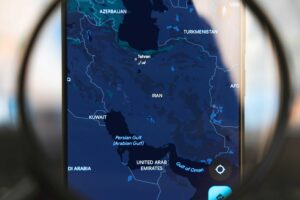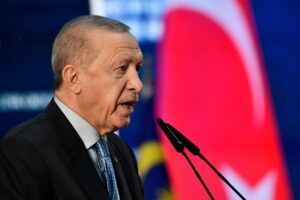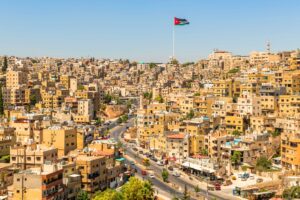The 9/11 attacks marked the apex of Osama bin Laden’s leadership[i], catapulting him to global infamy and solidifying his role as the symbolic leader of the jihadist movement. Bin Laden’s appeal to his followers was not just about his ability to orchestrate such headline-grabbing operations but lay in his ability to inspire and unite a decentralized network of jihadist groups under a common cause.
In the years following bin Laden’s assassination in 2011, few leaders with his charisma have emerged, none capable of unifying and rousing the fractured remnants of Al-Qaeda and its offshoots.[ii] This dearth of standout leaders raises important questions about the future of such movements and whether the absence of a central, charismatic figure will lead to the further fragmentation of global jihadism[iii] or the emergence of new forms of leadership that could reignite its influence.
Building the bin Laden brand: How a wealthy Saudi became a jihadist leader
Osama bin Laden was born into a wealthy and influential Saudi family, with access to immense resources and a privileged lifestyle.[iv] Bin Laden’s decision to give up material comforts in favour of a life dedicated to his interpretation of Islam resonated deeply with many of his followers, who saw in him a model of piety and sacrifice. This act of renunciation was not merely symbolic; it was a demonstration of his commitment to the cause of jihad, which he framed as a religious duty.
By living modestly and investing his wealth in jihadist activities, bin Laden distinguished himself from other wealthy elites in the Arab world, who were often perceived by the masses as corrupt and disconnected from the struggles of ordinary Muslims. This helped him cultivate an image of sincerity and authenticity, qualities that are crucial for charismatic leadership.[v] His personal sacrifices reinforced his message that the fight against perceived enemies of Islam was more important than personal gain, thereby earning him the respect and loyalty of those who shared his worldview.
Bin Laden’s rhetoric was filled with references to the Quran and the Hadith, which he used to justify his actions and rally support for his cause.
Bin Laden’s unwavering devotion to his faith further solidified his appeal. He positioned himself as a devout Muslim who was not only knowledgeable about Islamic teachings but also committed to living by them. His public image was carefully crafted to emphasize a person of religious piety. This religious devotion was instrumental in legitimizing his leadership[vi], especially among jihadist circles that valued religious authenticity. Bin Laden’s rhetoric was filled with references to the Quran and the Hadith, which he used to justify his actions and rally support for his cause. His portrayal of jihad as a sacred duty, sanctioned by religious texts, resonated with many Muslims who felt marginalized or oppressed by foreign powers. In this context, bin Laden’s religious commitment[vii] was not just a personal attribute but a powerful tool for mobilization and ideological influence.
The Afghan jihad against the Soviet Union in the 1980s was a turning point for bin Laden. It provided him with the opportunity to translate his ideological beliefs into concrete action. He played a significant role in organizing and funding the Mujahideen[viii], the guerrilla fighters who were resisting the Soviet occupation of Afghanistan.
This involvement was critical in establishing bin Laden’s credentials as a leader in the global jihadist movement. The Afghan jihad was widely regarded as a successful struggle against foreign occupation, and was framed as a model for future struggles against other perceived enemies of Islam. Bin Laden’s participation in it gave him the credibility he needed to extend his influence beyond Afghanistan and allowed him to build a network of jihadist fighters and supporters[ix], many of whom would later join Al-Qaeda.
Young Muslims across the globe were drawn to bin Laden through his speeches and media appearances, which emphasized themes of martyrdom, resistance against oppression, and the restoration of Islamic values. His strategic use of the media[x], including video messages and interviews, allowed bin Laden to project his ideology effectively, reaching potential recruits far beyond the confines of his immediate environment. His ability to create a sense of belonging and purpose among his recruits was a key factor in Al-Qaeda’s resilience and operational success.
The elusive legacy: Bin Laden’s death and the fragmentation of global jihad
In 2011, over nine years after 9/11, the United States Navy SEALs assassinated bin Laden. Even in death, however, he maintained his mystique. His ability to evade capture for so many years, despite being one of the most wanted men in the world, significantly enhanced his aura of invincibility. This elusiveness played into the narrative of bin Laden as a divinely protected warrior[xi], chosen to lead the struggle against the enemies of Islam.
While Al-Qaeda and similar groups continued to operate after bin Laden’s death, they could not find a leader with his charisma. Bin Laden was the ideological and symbolic heart of the organization, and without him Al-Qaeda’s global appeal and operational effectiveness eroded.[xii] The decentralized approach he once inspired became more pronounced but less directed. His successor, Ayman al-Zawahiri[xiii] was unable to inspire followers, and the group fractured, leading to the rise of splinter groups such as ISIS, which eventually eclipsed Al-Qaeda in prominence.
The transition period is a vulnerable time for the organization, as counterterrorism agencies intensify their efforts to exploit any weaknesses.
Becoming the new head of a terrorist organization is fraught with significant challenges[xiv], especially when succeeding a charismatic leader. Internally, the new leader must contend with inevitable comparisons to his predecessor, and might struggle to command the same level of authority and respect. Externally, the transition period is a vulnerable time for the organization, as counterterrorism agencies intensify their efforts to exploit any weaknesses. The successor becomes a prime target. Al-Zawahiri, for example, was the target of a global manhunt as soon as he was named bin Laden’s successor, hampering his ability to lead effectively.
Elevating one’s public profile as a new leader can have detrimental effects. In the age of global surveillance, digital tracking, and sophisticated intelligence networks, a leader who is frequently in the public eye presents a convenient target. This heightened visibility can lead to targeted strikes, as seen in the drone campaigns[xv] that have decimated the leadership of several terrorist groups. The leader of Al-Qaeda in the Arabian Peninsula (AQAP), Anwar al-Awlaki, was killed in Yemen in 2011, severely weakening AQAP’s propaganda and operational capabilities. In Pakistan, the Tehrik-i-Taliban Pakistan suffered major blows when its leaders, Baitullah Mehsud in 2009 and Hakimullah Mehsud in 2013, were killed by drones. The core leadership of Al-Qaeda has also been targeted, with Abu Yahya al-Libi, a top commander, killed in a drone strike in 2012. In Somalia, the emir of Al-Shabaab, Ahmed Abdi Godane, was eliminated by a U.S. drone strike in 2014, disrupting the group’s leadership.
Staying in the shadows: The hidden tactics of Al-Qaeda’s successive leadership
By avoiding the spotlight, al-Zawahiri managed to keep the organization operational, even if at a diminished capacity.
Given these risks, a strategic approach for new leaders may involve playing a more subdued role. By operating in the background, the leader can mitigate the immediate threats posed by counterterrorism efforts. This approach involves delegating public communication to trusted lieutenants[xvi], reducing direct involvement in operations that could compromise security, and focusing on internal consolidation rather than external projection of power.
A background role allows the new leader to stabilize the organization during the turbulent transition period. This strategy minimizes the chances of becoming the focal point of counterterrorism efforts, thereby preserving the leader’s ability to guide the organization through a critical phase. Maintaining a low profile can also create a level of ambiguity about the leadership structure, complicating counterterrorism efforts to identify and target key figures.
The late-stage Al-Qaeda under al-Zawahiri serves as a case in point. Al-Zawahiri did not have his predecessor’s charisma and did not command the same level of public attention, but this might have inadvertently benefited him. By avoiding the spotlight[xvii], he managed to keep the organization operational, even if at a diminished capacity, during a period when high visibility would likely have led to his quick elimination.
His leadership emphasized a decentralized but cohesive network, allowing affiliates in the Arabian Peninsula and Islamic Maghreb to operate with relative autonomy while remaining committed to Al-Qaeda’s broader vision of global jihad. This approach ensured the organization’s continued relevance and operational coherence until al-Zawahiri’s assassination in July 2022.[xviii]
Since the assassination of al-Zawahiri, al-Qaeda has not formally announced a definitive successor, which raises questions about the future leadership and direction of the organization.[xix] Saif al-Adel, a veteran jihadist and former Egyptian Special Forces officer, was widely believed to be his successor, however, the group has been notably secretive about its leadership transitions, likely to protect the new leader from becoming a target.
[i] Post, J.M. (2002). “Killing in the Name of God: Osama bin Laden and Al Qaeda”, Future Warfare Series, 18, retrieved from: https://irp.fas.org/world/para/post.pdf.
[ii] Byman, D.L. (2011). “Al Qaeda After Osama”, Brookings, May 2011, retrieved from: https://www.brookings.edu/articles/al-qaeda-after-osama/.
[iii] Bakker, E. and Boer, L. (2007). “The evolution of Al-Qaedaism”, Netherlands Institute of International Relations, December 2007, retrieved from: https://www.clingendael.org/sites/default/files/pdfs/20071200_cscp_csp_bakker_boer.pdf.
[iv] Torok, R. (2011(. “Bin Laden’s formation of the self: a comparative analysis”, Australian Counter Terrorism Conference, January 2011, retrieved from: https://ro.ecu.edu.au/cgi/viewcontent.cgi?article=1013&context=act.
[v] Ingram, H.J. (2014). The Charismatic Leadership Phenomenon in Radical and Militant Islamism, London: Routledge.
[vi] EveryCRSReport.com (2007). “Al Qaeda: Statements and Evolving Ideology”, retrieved from: https://www.everycrsreport.com/reports/RL32759.html.
[vii] Gunaratna, R. (2005). “Al Qaeda’s Ideology”, Hudson Institute, May 2005, retrieved from: https://www.hudson.org/national-security-defense/al-qaeda-s-ideology.
[viii] Hoodbhoy, P. (2005). “Afghanistan and the Genesis of Global Jihad”, Peace Research, 37)1), 15-30, retrieved from: https://www.jstor.org/stable/24469676.
[ix] Huntington, S.P. (2007). “Al-Qaeda: a blueprint for international terrorism in the twenty-fist century?”, Defence Studies, 4(2), 229-255, retrieved from: https://www.tandfonline.com/doi/pdf/10.1080/1470243042000325922.
[x] Jeffords, S. and Al-Sumait, F. (eds.) (2015). Covering Bin Laden: Global Media and the World’s Most Wanted Man, Champaign: University of Illinois Press.
[xi] Mayer, J. (2003). “The Search for Osama”, The New Yorker, July 2003, retrieved from: https://www.newyorker.com/magazine/2003/08/04/the-search-for-osama.
[xii] Jenkins, B.M. (2016). “Five Years After the Death of bin Laden, Is the World Safer?”, RAND, May 2016, retrieved from: https://www.rand.org/pubs/commentary/2016/05/five-years-after-the-death-of-osama-bin-laden-is-the.html.
[xiii] Radman, H. (2022). “Al-Zawahiri’s Death and the End of Bin Laden’s Legacy”, (2022), August 2022, retrieved from: https://sanaacenter.org/the-yemen-review/july-2022/18402.
[xiv] Mendelsohn, B. (2021). “Casting Shadow: Founders and the Unique Challenges of a Terrorist Group’s First Leadership Challenge”, 5 December 2021, retrieved from: https://www.tandfonline.com/doi/full/10.1080/1057610X.2021.2018903#:~:text=These%20four%20main%20challenges%20are,try%20to%20prove%20them%20empirically.
[xv] Congressional Research Service (2023). “Armed Drones: Evolution as a Counterterrorism Tool”, 7 November 2023, retrieved from: https://crsreports.congress.gov/product/pdf/IF/IF12342.
[xvi] Hankiss, A. (2019). “Behind the Scenes of Al-Qaida’s Media Strategy”, Journal of Strategic Security, 12(2), 60-76, retrieved from: https://digitalcommons.usf.edu/cgi/viewcontent.cgi?article=1714&context=jss.
[xvii] Al Jazeera (2022). “Who was al-Qaeda’s leader Ayman al-Zawahiri?”, 2 August 2022, retrieved from: https://www.aljazeera.com/news/2022/8/2/al-zawahiri-from-cairo-doctor-to-al-qaeda-leader.
[xviii] Harrington, J. and Thompson, J. (2022). “Zawahiri’s Death and What’s Next for al Qaeda”, CSIS, 4 August 2022, retrieved from: https://www.csis.org/analysis/zawahiris-death-and-whats-next-al-qaeda.
[xix] Bacon, T. and Grimm, E. (2022). “What Leadership Type will Succeed Al-Qaeda’s al-Zawahiri?”, ICCT, 15 July 2022, retrieved from: https://www.icct.nl/publication/what-leadership-type-will-succeed-al-qaedas-al-zawahiri.

















